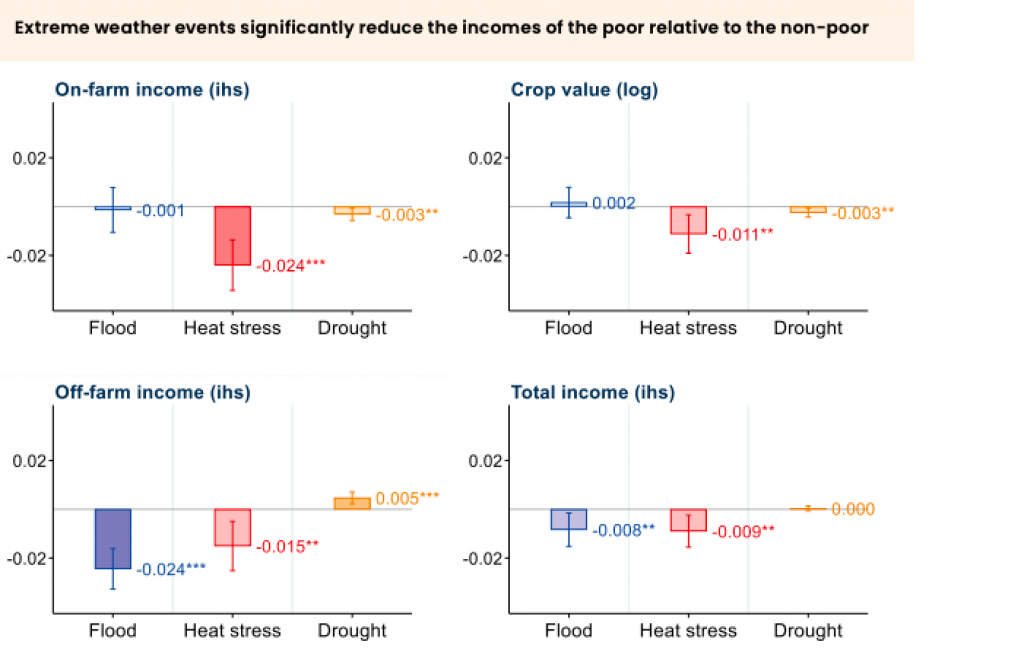Every day of extreme precipitation causes poor households to lose 0.8 per cent of their incomes relative to non-poor households
With every day of extreme heat, poor rural households lose 2.4 per cent of their on-farm incomes, 1.1 per cent of the value of the crops they produce and 1.5 per cent of their off-farm income, relative to non-poor households in India and 23 other low-and-middle-income-countries (LMIC). This was highlighted in a new report from the Food and Agriculture Organization of the United Nations (FAO).
If the average long-term temperatures were to increase by 1°C, rural poor households will be pushed to depend more on climate-sensitive agriculture and lose off-farm opportunities, the findings showed.
This is because poor households tend to reduce the diversity of their income sources when exposed to heat stresses, relative to better-off households. So, on one hand, the rural population will be impacted by the adverse impacts of climate change in agriculture but on other, they won’t have many opportunities in non-agriculture work and will have to rely on weather-dependent agriculture. This will lead to a 33 per cent decrease in the off-farm incomes and 53 per cent, according to the authors of the report.
Thus, while better-off households adapt to rising temperatures by diversifying into off-farm sectors, poor households cannot. This likely increases their overall vulnerability to the impacts of climate change.
Similarly, every day of extreme precipitation causes poor households to lose 0.8 per cent of their incomes relative to non-poor households, mostly driven by losses in off-farm incomes, the analysis showed.
The report The Unjust Climate underlined how extreme weather events disproportionately affect poor rural households, leading to significant reductions in their incomes and thus, widening the existing income inequality.
For the report, FAO analysed socioeconomic data from over 100,000 rural households, representing more than 950 million people, across 24 LMICs. By integrating this information with 70 years of georeferenced daily precipitation and temperature data, the report examines how various climate stressors impact people’s incomes, labour and adaptation strategies, differentiating based on their wealth, gender and age.

In an average year, poor households lose 5 per cent of their total income due to heat stress relative to better-off households and 4.4 per cent due to floods.
In fact, extreme weather events push poor rural households to adopt maladaptive coping strategies, including distress sale of livestock and redirecting expenditures away from their farms.
The study measured sensitivity to climate stressors among rural people using survey data that measure households’ on-farm, off-farm and total incomes, as well as labour dynamics. It measures exposure to various climate stressors like floods, heat stress, drought using long-term, daily georeferenced precipitation and temperature data.
The findings illustrated that poor households reduce their investments in agriculture relative to non-poor households when faced with floods and droughts, as they redirect their scarce resources away from agricultural production towards immediate consumption needs. These maladaptive coping strategies are likely to make them more vulnerable to future climate stressors than non-poor rural households.
Floods and heat stress widen the income gap between poor and non-poor households in rural areas by approximately $21 billion a year and $20 billion a year, respectively, the researchers observed.
These estimates also highlighted the massive challenge extreme weather events pose for global efforts to reduce poverty and inequality. “This challenge will only become more acute as the frequency and intensity of these events increase because of climate change,” the researchers wrote in the report.
However, rural people and their climate vulnerabilities are barely visible in national climate policies. In the nationally determined contributions (NDC) and national adaptation plans (NAP) of the 24 countries analysed in this report, less than 1 per cent mention poor people and about 6 per cent refer to farmers in rural communities.
And of the total tracked climate finance in 2017-18, only 7.5 per cent went towards climate change adaptation; less than 3 per cent to agriculture, forestry and other land uses, or other agriculture-related investments; only 1.7 per cent, amounting to roughly $10 billion, reached small-scale producers.
We are a voice to you; you have been a support to us. Together we build journalism that is independent, credible and fearless. You can further help us by making a donation. This will mean a lot for our ability to bring you news, perspectives and analysis from the ground so that we can make change together.












































